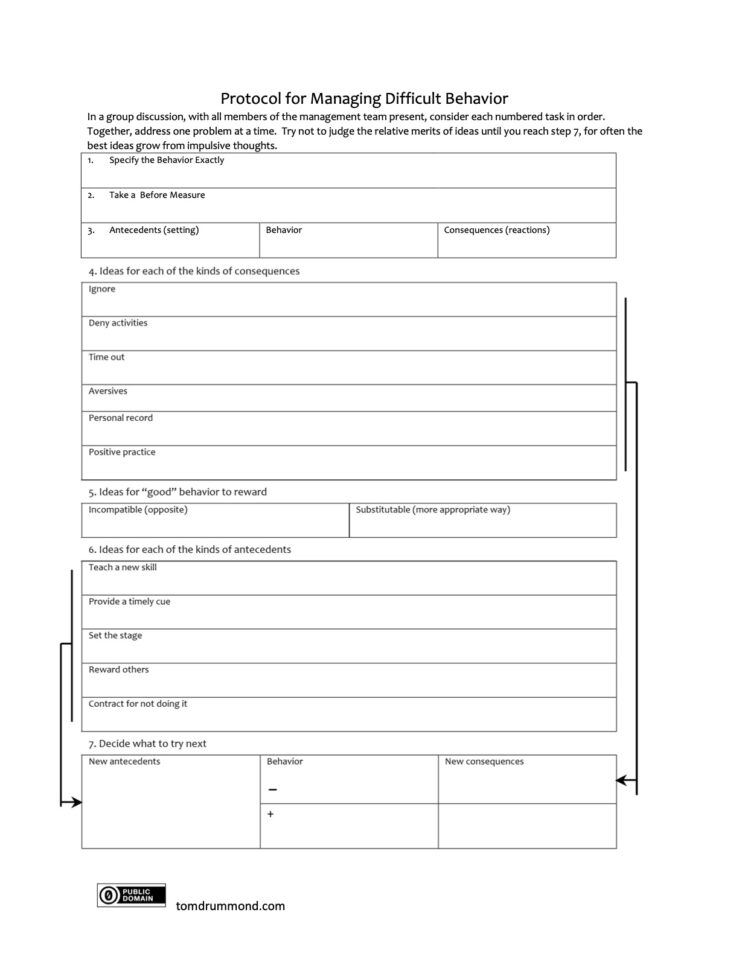Behavior Management Protocol
If you reached this page in sequence, you had to pass through many other ideas first. I put this topic last on the assumption that educators and parents, in fact all of us, have to do some personal work to be authentic, clarify our purpose, clearly communicate expectations, and be warmly accepting and caring, especially when we are upset. A challenging child is the perfect opportunity to show us our “Oops” where we have something to learn. Now you have arrived at the door of the Behavior Management Protocol where we address, in cooperation with others, those difficult problems that are not going away. We have to take a significantly different approach.

When I first began to work with young children in 1970, I volunteered at the Experimental Education Unit at the Haring Center of the University of Washington, which was dedicated to research, professional development, and services for children with disabilities. I encountered some of the toughest children I have seen, so I confidently feel I have been taught by the best.
This Behavior Management Protocol gathers together what I have learned in dealing with very hard behavior problems — the tough guys and gals. The protocol provides a logical sequence for a cooperative effort by those involved with a child to plan, document, reflect, and create effective conditions to help a child they all know. If you have difficult behavior challenges that drag on and on, and have been applying the lessons from the previous pages, this protocol is for you.
Overview
Nineteen pages open from this portal. Each page incrementally presents a system for involving all the managers (educators, staff, families) in investigation and problem-solving to arrive at a community-constructed plan for dealing with a child when nothing else is working. Links to those pages are at the bottom of the page.
There are no answers here. Rather, we agree to try this protocol as an agenda for considering all possible options to choose from and become able to implement with committed action.
Fair warning: this is lots of work over multiple meetings with all the people involved and continuous record keeping in between.
We arrive here because the educators, staff, and families are at a loss. We have found ourselves unsuccessful and emotionally drained. We all care about this child who continues destructive and counterproductive ways despite our best efforts, without any apparent solution.
Time Passes Quickly
When children is still young, we can turn this around if we act fast. The worst problem is watching children turn six with hardened, non-productive habits, which drastically limit their opportunities, as many experiences, adventures, and encounters will be closed for the rest of their lives.
I assume, since you are reading this, that you have already worked on direct, honest communication and invested effort in growing a personal relationship of listening and care. For I have often found that tough behaviors simply go away when people have positive relationships with others, especially in these early years. When we admit we are not moving fast enough, we need the Behavior Management Protocol, because it offers a streamlined way to change what we do. It’s not easy to suddenly change our ways of behaving, but we must. No one else can do it.
Systematic Collaboration
The protocol is effective because the team has more ideas than each of us does alone. Building a cohesive team requires a clear, systematic way to optimize the group’s ability to see what they need to change and be committed to doing the changing. A managing protocol doesn’t change the child; it changes us.
Without a clear protocol, meetings often are not productive. Usually a discussion is dominated by opinions, not action. Discussions can go round and round without making a decision on what to do.
The agenda of the protocol controls the sequence of topics and the discussion of specific alternatives based on facts, not opinions. The reality is addressed first, then conclusions drawn that provide a basis for a commitment among the managers. The protocol organizes an efficient, collaborative dialogue for discovering what works by constructing a common understanding, guiding members through a logical progression, and structuring the components of a final agreement.
Navigation
Before we step through the protocol I’d like to begin with a discussion of Language and Reality to distinguish objective facts and socially constructed meaning from opinion.
Following that understanding, the sequence proceeds by clicking on the NEXT link in the blue box at the bottom of the page. I recommend following this big blue link, so topics arise in the protocol sequence.
This set of links provides access to the individual pages.
-
Navigation Links
EXAMINE THE BEHAVIOR
INITIATE A PROGRAM
When all seven numbered topics are understood, the management team makes a decision using this form.
You can see the protocol at work in examples of three children: Sandy, Jeremy, and Charlie.
Before we start into the details, we examine the ways we talk about what’s happening: Language and Reality. We have to draw a few distinctions in order to have a common language for the work.
